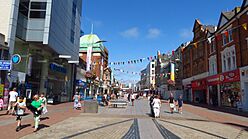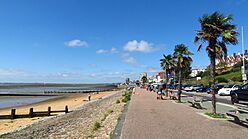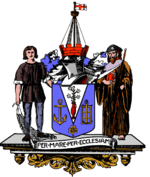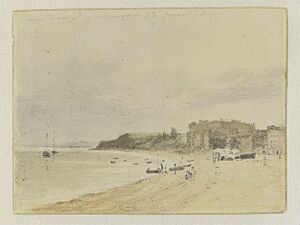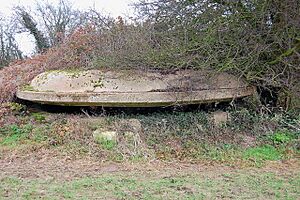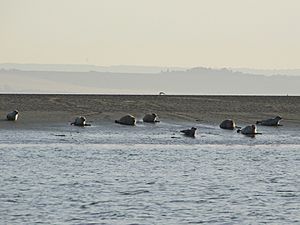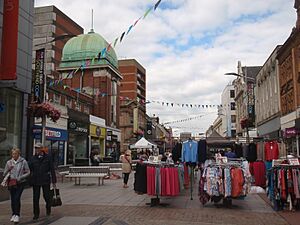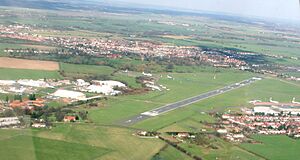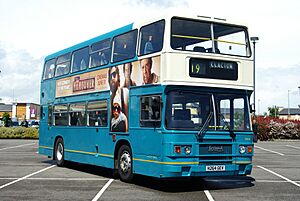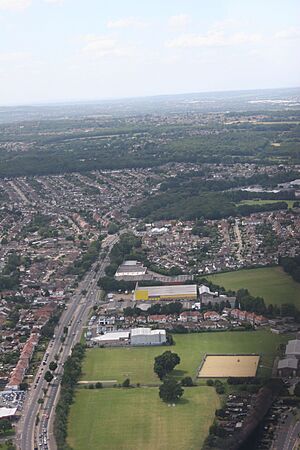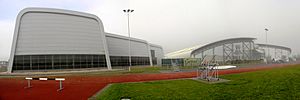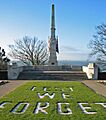Southend-on-Sea facts for kids
Quick facts for kids
Southend-on-Sea
|
||
|---|---|---|
|
|
||
|
||
| Motto(s):
Per Mare Per Ecclesiam
(By Sea, By Church) |
||
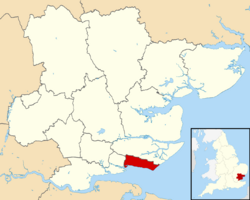
Shown within Essex
|
||
| Country | United Kingdom | |
| Constituent country | England | |
| Region | East of England | |
| Ceremonial county | Essex | |
| Admin HQ | Southend-on-Sea | |
| Areas of the city |
List
Chalkwell
City Centre Eastwood Leigh-on-Sea (Town) North Shoebury Prittle Brook Prittlewell Shoeburyness Southchurch Thorpe Bay Westcliff-on-Sea |
|
| Government | ||
| • Type | Unitary authority | |
| Area | ||
| • Total | 16.12 sq mi (41.76 km2) | |
| Population | ||
| • Total | Ranked by District 103rd 183,125 |
|
| Ethnicity (2021) | ||
| • Ethnic groups |
List
|
|
| Religion (2021) | ||
| • Religion |
List
44.9% no religion
42.6% Christianity 9.5% other 3% Islam |
|
| Time zone | UTC+0 (GMT) | |
| • Summer (DST) | UTC+1 (British Summer Time) | |
| Postcode |
SS0-SS3
|
|
| Post town |
southend-on-sea
|
|
| Dialling code | 01702 | |
| ISO 3166 code | GB-SOS | |
| Grid reference | TQ883856 | |
| ONS code | 00KF (ONS) E06000033 (GSS) |
|
Southend-on-Sea, often called Southend, is a city on the coast in south-eastern Essex, England. It sits on the north side of the Thames Estuary, about 40 miles (64 km) east of central London. The city is very busy, with many people living there. It is famous for having the longest pleasure pier in the world, Southend Pier. Also, London Southend Airport is just north of the city centre.
Southend-on-Sea started as a small group of fishermen's huts and a farm. This was at the southern end of the village of Prittlewell. In the 1790s, the first buildings were finished around what is now Southend's High Street. In the 1800s, Southend became a popular seaside resort. This happened after the Princess of Wales, Caroline of Brunswick, visited. The building of the pier and a railway also helped, making it easier to get there from London.
After the 1960s, Southend became less popular as a holiday spot. The city centre changed a lot, with many old buildings replaced by shops and businesses. Southend also became home to the Access credit card. This was because it had one of the UK's first electronic telephone systems. For many years, an airshow with planes like Concorde took place every May. It ran from 1986 until 2012.
Southend was officially made a city on January 26, 2022. This was done to remember Sir David Amess. He was a Member of Parliament for Southend West and had long wanted the area to become a city. He passed away in October 2021. On March 1, 2022, Charles, Prince of Wales, presented the official papers to the Southend Borough Council.
Contents
- Southend's Past: A Journey Through Time
- Southend's Landscape: Geology and Climate
- How Southend is Run: Governance
- Southend's People: Demographics
- Southend's Money: Economy
- Getting Around: Transport in Southend
- Learning in Southend: Education
- Fun and Games: Sport in Southend
- Entertainment and Culture in Southend
- Southend Pleasure Pier
- The Kursaal Amusement Park
- Southend Carnival
- Cliff Lift
- Other Seafront Attractions
- Festivals and Events
- Parks and Nature Reserves
- Buildings and Architecture
- Art, Galleries, Museums, and Libraries
- Theatres in Southend
- Cinema and Film
- Music in Southend
- Radio in Southend
- Television in Southend
- Places of Worship
- Twin Town
- Notable People from Southend
- Freedom of the City
- See also
Southend's Past: A Journey Through Time
How Southend Began
Southend was first mentioned in 1309 as Stratende. It was a small piece of land in the area of Milton, which is now Westcliff-on-Sea. It was part of the larger Prittlewell parish. In 1408, the area south of Prittlewell was called Sowthende.
In 1665, a British naval ship, The London, exploded near Southend. It was on its way to fight in the Second Anglo-Dutch War. For a long time, Southend was just a few fishermen's huts and a farmhouse. In 1758, a large house was built, which later became the Ship Inn. More cottages were built in 1767. By 1781, the first bathing machine arrived, letting people swim in the sea. People started to see Southend as a good place for visitors.
The Rise and Fall of New South-End
In 1790, Daniel Scratton, a local landowner, set aside land for a new development. It was called New South-End, and the original area became Old South-end. A new road was built, which is now the High Street. Builders started working on houses and a hotel. By 1793, the Grand Hotel, now The Royal Hotel, opened.
However, the new development struggled. It aimed for rich visitors, but instead, attracted middle-class people. The main builders went bankrupt. In contrast, Old South-end grew, adding more pubs and shops.
Growing into a Town
Southend did not grow as fast as other seaside towns like Brighton at first. This was because it was hard to travel there from London. In 1801, Princess Charlotte of Wales visited, which made Southend more popular. Later, Lady Hamilton and Lord Nelson also visited.
Boats could only dock at high tide because of the shallow mudflats. This made it hard for large ships to reach the shore. To fix this, local leaders decided to build a pier. The first part of Southend Pier opened in 1830.
In 1856, the London, Tilbury and Southend Railway finally opened, connecting Southend to London. This made it much easier for people to visit. In 1859, a new area called Clifftown was built, with houses offering sea views. The railway helped Southend grow, especially after the Bank Holidays Act 1871 gave more people time off for holidays.
The town bought the pier in 1873 and built Marine Parade in 1878. In 1889, a new, stronger iron pier opened. Southend became an official town in 1892 and added "on-sea" to its name a year later. The population grew from 2,800 in 1871 to 29,000 in 1901.
In 1901, The Kursaal amusement park opened. The town also got electric street lights and trams. A statue of Queen Victoria was placed at the top of Pier Hill. By 1911, Southend's population was 62,723, making it the fastest-growing town in England. In 1914, Southend became a county borough, meaning it had its own police force.
Southend During World War I
When World War I started, German citizens were held on ships near the pier. The War Office built an airfield north of the town. Many soldiers passed through Southend on their way to the war. The pier was used for troop ships, and Southchurch Park became an army training ground.
Southend was bombed by German Zeppelins in 1915 and by Gothas in 1917. Several people died in these attacks. Some hotels, like the Metropole, were turned into hospitals for wounded soldiers. When the war ended in 1919, Southend celebrated with a large Naval review and a carnival.
Between the Wars: Growth and Change
After World War I, Southend continued to grow. Many people moved from London for better living conditions. The town's population reached 106,050 in 1921. The council bought German U-boat engines to power the tram network.
In 1924, the Sunken Gardens next to the pier became Peter Pan Playground, a fun place for children. The pier head was made bigger in 1929 to handle more visitors arriving by paddle steamer. In 1930, EKCO, a famous local company, opened a large factory. New housing areas like Earls Hall were built.
In 1931, the London Taxi Drivers Charity for Children started their first taxi drive to Southend. They brought children to the town for a fun day out. Southend also tried autumn illuminations in 1935, like Blackpool. The town became popular with motorcycle riders.
Southend During World War II
Southend played an important role in World War II. In 1939, the Royal Navy took over Southend Pier, calling it HMS Leigh. Anti-aircraft guns were placed on the pier. The pier helped control the River Thames and organize convoys.
The town was heavily defended with anti-tank blocks and machine gun posts. Southend Airport was used by the RAF and renamed RAF Rochford. In May 1940, Southend was first bombed by Germans. Many residents were evacuated, and the town was sealed off.
In May 1940, six local fishing boats and the Southend lifeboat helped rescue soldiers from Dunkirk evacuation. In 1942, the seafront became HMS Westcliff, a large naval training camp. Lord Mountbatten secretly opened it in 1943. German radio sometimes joked about sinking HMS Westcliff and HMS Leigh.
Southend faced attacks from V1 and V2 rockets until December 1944. One rocket hit the Pavilion on the pier. In 1944, a ship carrying explosives, the SS Richard Montgomery, sank near Southend. Before D-Day in June 1944, HMS Leigh was where 576 ships gathered before heading to Normandy.
After the Wars: Decline and Rebirth
After the war, Southend quickly reopened to visitors. The pier was officially open again in March 1945. People returned in large numbers, with 79,000 visitors in the first 19 days. By 1949-50, over 5.75 million people visited the pier.
On January 31, 1953, the North Sea flood affected Southend's seafront. Peter Pan's Playground was underwater. In 1956, the railway line to London was made electric. This encouraged more Londoners to move to Southend, turning it into a commuter town.
The council worried that Southend relied too much on tourism. They decided to grow the business industry. In the 1960s, a new Civic Centre was built. It included a police station, courthouse, and council offices. A new shopping centre, Victoria Circus, opened in 1970.
In 1969, Southend's police force joined with Essex Constabulary. The number of visitors to the pier dropped a lot. In 1976, the pier head burned down. In 1978, the pier railway closed because it was in bad condition. The Kursaal amusement park also mostly closed in 1973.
Southend became one of the first towns to get an electronic telephone exchange in 1971. In 1972, Access, a new credit card company, opened its offices in Southend. In 1980, Southend was known more as a business centre. The pier was saved after a campaign, and a new railway was installed, reopened by Princess Anne in 1986.
The Southend Airshow started in 1986, becoming Europe's biggest free airshow. It ran until 2012. New attractions opened, like the Sealife Centre in 1993. Peter Pan's Playground expanded and became Adventure Island in 1995. The Kursaal building reopened in 1998 with a bowling alley and casino.
In 2003, an Anglo-Saxon royal burial from the 6th century was found during road work. The finds are now displayed at Southend Central Museum. Many former offices in Southend have been turned into apartments.
Becoming a City
On October 18, 2021, Prime Minister Boris Johnson announced that the Queen had agreed to make Southend-on-Sea a city. A "City Week" was held in February 2022 to celebrate. On March 1, Charles, Prince of Wales, officially presented the city status papers. Southend became the second city in Essex, after Chelmsford.
Southend's Landscape: Geology and Climate
Understanding Southend's Ground
The cliffs along Southend's coast are made of London Clay. This clay is covered by sand, gravel, and river mud from the Ice age. The cliffs have had problems with slipping due to groundwater. Major slips happened in 1956, 1962, 1964, and 1969. In 2002, a large slip badly damaged the cliffs' bandstand and restaurant. A £2.8 million project in 2013 helped make the cliffs stable.
Southend's Weather
Southend-on-Sea is one of the driest places in the UK. It has a marine climate, meaning it's influenced by the sea. Summer temperatures are usually around 22°C (72°F). Winter temperatures are around 7.8°C (46°F). Frosts don't happen very often. From 1991 to 2020, there were about 30 days of air frost each year. The average rainfall is about 527 mm (20.7 inches).
How Southend is Run: Governance
Local Government Today
Southend is governed by Southend-on-Sea City Council. This council is a unitary authority, which means it handles all local government services. There is one civil parish in the city, Leigh-on-Sea, which has its own Town Council. The rest of the city is managed directly by the City Council.
The city is divided into 17 wards, and each ward elects three councillors. These 51 councillors serve for four years. As of the 2024 local elections, a group led by the Labour party runs the council.
Southend's Coat of Arms and Twin Town
Southend's motto, 'Per Mare Per Ecclesiam', is Latin for 'By the Sea, By the Church'. This shows the city's location between the church at Prittlewell and the Thames estuary. Southend is twinned with Sopot in Poland, a partnership that started in 1999.
Members of Parliament (MPs)
Southend has two Members of Parliament who represent the city in the UK Parliament. These seats are Southend East and Rochford, and Southend West and Leigh. In the 2024 United Kingdom general election, Bayo Alaba and David Burton-Sampson, both from the Labour party, were elected. This was the first time Labour MPs were elected for Southend since 1918.
Historically, Southend's MP seats were often held by the Conservative party for a long time. Famous past MPs include Rupert Guinness and his wife Gwendolen Guinness. Later, Sir David Amess served as MP for Southend West from 1997 until his passing in 2021.
Southend's People: Demographics
Population Density
Southend is one of the most crowded areas in the UK outside of London. It has about 38.8 people per hectare, which is much higher than the national average.
Southend's Wider Urban Area
The larger urban area of Southend extends beyond the city's borders. It includes nearby towns like Hadleigh, Benfleet, Rayleigh, and Rochford. According to the 2011 census, this wider area had a population of 295,310 people.
Poverty and Employment
In 2008–09, about 4,000 children in Southend lived in poverty. This was 12% of children, similar to Thurrock. Some areas in Southend are among the most deprived in England.
As of May 2024, the employment rate for people aged 16-64 in Southend was 75.6%. The unemployment rate was 5.2%. Most working people (69.1%) have full-time jobs. About one-fifth of the working population travels to London every day for work. Wages for jobs in Southend were among the lowest in UK cities in 2015.
Population by Age
In the 2021 census, Southend's population was 180,686. Slightly more than half (51.3%) were female, and 48.7% were male. Most people (87.5%) were born in the UK. For those born outside the UK, most came from Europe and had lived in the UK for over 10 years. Nearly 33,000 people in Southend were retired.
Southend's Money: Economy
Main Industries Today
Tourism is still a very important industry in Southend. Over 7,500 people work in this sector. In 2019, visitors spent over £360 million in the city. Rossi's Ice-cream is a famous local business that has been around since 1932.
Aerospace is another key industry. London Southend Airport is one of EasyJet's bases. There are also aircraft maintenance companies and Ipeco, a company that makes aircraft seats.
Other manufacturing companies in Southend include MK Electric, which makes electrical products, and Olympus UK & Ireland, which specializes in medical equipment.
Financial services are also a big employer. NatWest's credit card operations are in Southend. InsureandGo, a travel insurance company, is also located here. Southend has industrial areas with various businesses, including Hi-Tec Sports. Most companies in Southend are small, with nine or fewer employees.
Past Industries
EKCO was a big electronics company started by Eric Kirkham Cole in 1926. It made radios, televisions, and plastics. At its peak, it employed over 8,000 people. The company closed its television and radio manufacturing in 1966. The factory site was later used by Access credit card.
Access credit card opened its offices in Southend in 1972. It was the second credit card company in the UK. They used the old EKCO factory. Over time, many credit card companies left Southend, but NatWest still has operations there.
HM Revenue and Customs (HMRC) used to employ over 4,000 people in Southend. They had several large offices. However, HMRC announced in 2015 that they would close their Southend offices. Many of these former offices are now being turned into flats.
Retail and Shopping
Southend High Street is the main shopping area. It has two shopping centres: The Victoria and The Royals. The High Street mostly has big chain stores. However, since the COVID-19 pandemic, there are more empty shops.
Other areas in Southend offer different shopping experiences. The Broadway in Leigh-on-Sea is known for its unique independent shops and coffee places. Hamlet Court Road in Westcliff-on-Sea was once a very fancy shopping street. Southend also has regular vintage fairs and markets.
Dixons Retail, now Currys plc, started in Southend in 1937 and is still a big company today.
Famous Shops from the Past
Southend used to have many well-known independent stores:
- Keddies was a famous department store that opened in 1892. It closed in 1996.
- J F Dixons was a department store that closed in 1973.
- Havens was a department store in Westcliff-on-Sea that closed its physical store in 2017 to focus on online sales.
- Garons was a grocer that expanded into cinemas and catering. The family later donated land for Garon Park.
- R. A. Jones was a jeweller and a generous supporter of the town. His store closed in 1979.
- Ravens was the longest-running independent shop in Southend, an outfitters that closed in 2017.
Getting Around: Transport in Southend
London Southend Airport
London Southend Airport started as a military airfield and opened for public flights in 1935. In the 1960s, it was the UK's third-busiest airport. After a decline, it was rebuilt starting in 2010. Now, it offers flights to Europe, corporate flights, and pilot training. It has its own train station, Southend Airport railway station.
Buses in Southend
Local bus services are mainly run by Arriva Southend and First Essex Buses. Arriva Southend used to be owned by the council. Southend has a bus station called the Southend Travel Centre.
Trains in Southend
Southend has two main train lines:
- From Southend Victoria, trains go to London Liverpool Street.
- From Shoeburyness in the east, trains go through Southend to London Fenchurch Street.
Southend also has two smaller railways. The Southend Pier Railway takes people along the pier. The Southend Cliff Railway connects the seafront to the top of the cliffs.
Roads in Southend
Two main roads connect Southend to London: the A127 and the A13. Both roads link to the M25 motorway and eventually to London.
Learning in Southend: Education
Secondary Schools
Southend has different types of secondary schools. There are mixed-sex comprehensive schools like Belfairs Academy and Cecil Jones Academy.
Southend also has four grammar schools: Southend High School for Boys, Southend High School for Girls, Westcliff High School for Boys, and Westcliff High School for Girls. These schools select students based on academic ability.
Additionally, there are two single-sex Roman Catholic schools: St Bernard's High School for girls and St Thomas More High School for boys.
Higher and Further Education
The main university in Southend is the University of Essex. It has a campus that opened in 2007. The university also runs the East 15 Acting School Southend campus.
The largest provider of further education is South Essex College. It has a modern building in the town centre. Other options include PROCAT and USP College in Thundersley. The East 15 Acting School, a drama school, has its second campus in Southend.
How Education Developed in Southend
Primary Schools
The first school in Southend opened in Prittlewell in 1727. It was supported by donations and small weekly payments. By 1879, a new school called London Road Schools opened for over 500 pupils. As Southend grew, more schools were built, like Brewery Road School and Leigh Road School.
Secondary and Further Education
In 1882, evening classes for art and science started in Southend. These classes became very popular. In 1895, a Technical Institute was built, which also had a day technical school.
In 1902, a new building opened at Victoria Circus for the Day Technical School, Evening Technical Institute, and School of Art. In 1913, the girls moved to the new Southend High School for Girls. The Day Technical School was renamed Southend High School for Boys.
In 1922, the Commercial School opened, which later became Westcliff High School. By 1926, the boys' school moved to its current site. The girls' school, Westcliff High School for Girls, moved in 1930. In 1935, the Technical and Commercial school became Southend Municipal College. This college later became South Essex College.
Fun and Games: Sport in Southend
Southend United is the city's only professional football club. They play in the Vanarama National League. The city also has another senior club, Southend Manor.
Southend has two rugby union clubs: Southend RFC and Westcliff R.F.C.. The city used to have rugby league and basketball teams.
Essex County Cricket Club used to play in Southend every year until 2011. The Southend Cricket Festival was held at Chalkwell Park and Southchurch Park, and later at Garon Park.
The Old Southendians Hockey Club is based at Warner's Bridge. The Southend Leisure and Tennis Centre has an athletics track and a swimming pool with diving boards. Southend has hosted a half marathon race since 1996.
Entertainment and Culture in Southend
Southend Pleasure Pier
-
A mile out along the pier
Southend-on-Sea is home to the world's longest pleasure pier. It was first built in 1830 from wood, then rebuilt with iron in 1889. The pier stretches about 1.34 miles (2.16 km) into the Thames Estuary. It is a Grade II listed building. The pier has had a small railway since 1846.
The Kursaal Amusement Park
The Kursaal was one of the first theme parks, opening in 1901. It closed in the 1970s, and much of the land was used for housing. The main entrance building, a listed building, was redeveloped in 1998 to include a bowling alley and a casino. However, the bowling alley closed in 2019 and the casino in 2020. The building is currently empty.
Southend Carnival
Southend Carnival has been an annual event since 1906. It started to raise money for the local hospital. The carnival used to have daylight and torchlight parades. It has not run since 2020, but efforts are being made to restart the parade.
Cliff Lift
A short funicular railway, built in 1912, connects the seafront to the High Street. It runs where an early moving walkway used to be. The lift reopened in 2010 after being renovated.
Other Seafront Attractions
Adventure Island, an amusement park, is located near the pier entrance. The seafront also has the "Sea-Life Adventure" aquarium.
Southend has four Keep Britain Tidy Blue Flag awarded beaches: East Beach, Shoebury Common, Three Shells, and Westcliff Bay. A modern lift connects the High Street to the seafront.
Former Attractions
The cliff gardens, which included Never Never Land and a Victorian bandstand, were popular until a landslip in 2003 made parts of the cliffs unsafe. The bandstand was moved to Priory Park.
Festivals and Events
The Southend-on-Sea Film Festival started in 2009. Ray Winstone is the Festival Patron. Southend also hosts the Horror-on-Sea festival for independent horror films.
Since 2021, the city has had a Halloween parade in October. The Leigh Art Trail happens in July. Southend City Jam, a street art festival, and LuminoCity, a light festival, started in 2022. LuminoCity was cancelled for 2024 due to budget cuts. The Old Leigh Regatta takes place every September. The Leigh Folk Festival has run since 1992.
The London to Southend Classic Car Run happens every summer. The Southend Shakedown is an annual event for motorbikes and scooters.
Parks and Nature Reserves
Southend has many parks and green spaces. Its first formal park was Prittlewell Square. Other parks include Priory Park, Chalkwell Park, Southchurch Park, and Garon Park.
Part of Southend's foreshore is a special area for wildlife. There are also nature reserves at Belfairs and Belton Hills.
Buildings and Architecture
Southend has several Conservation areas and many listed buildings.
Interesting Buildings
The Royal Terrace, built between 1791 and 1793, is a rare example of 18th-century housing in Essex. It is a Grade II listed building.
St Mary's Church, Prittlewell is a Grade I listed church that dates back to Saxon times. It is the oldest building in the city.
Southend-on-Sea War Memorial is a Grade II* listed stone monument in Clifftown. It was finished in 1921.
Porters is a medieval Manor house. The current house was built in the 15th or 16th century. It became the Mayor's parlour and civic house in 1935 and is a Grade I listed building.
Art, Galleries, Museums, and Libraries
-
Southend Central Museum, Victoria Avenue
Southend Museums manages two historic houses: Southchurch Hall and Prittlewell Priory. They also run the Beecroft Art Gallery and the Southend Central Museum and Planetarium. The museums have about 50,000 objects, including items from the famous Prittlewell Princely Burial.
Other museums include The Jazz Centre UK and Southend Pier Museum. Focal Point Gallery, in The Forum, shows modern art. The Old Waterworks Arts Center hosts exhibitions and workshops.
Metal, an art organization, is based at Chalkwell Hall. They organize the Village Green Art & Music Festival. The park is also home to NetPark, the world's first digital art park.
Southend has several small libraries and a central library in The Forum. The old Central Library building now houses the Beecroft Gallery and the Jazz Centre UK.
Theatres in Southend
Current Venues
Southend has several theatres:
- The Edwardian Palace Theatre opened in 1912. It shows plays and comedy acts.
- The Cliffs Pavilion is the largest arts venue in Essex. It opened in 1964 and hosts concerts, shows, and pantomimes. Famous artists like Paul McCartney and Oasis have performed there.
- The Clifftown Theatre is part of the East 15 Acting School campus.
Former Venues
Southend used to have many more theatres. The New Empire Theatre closed in 2009 and was later demolished after a fire. Other past venues included the Floral Hall and the Sundeck Theatre on the pier. The largest lost theatre was the Hippodrome, which became a cinema.
Cinema and Film
Southend has one cinema, the Odeon Multiplex at Victoria Circus, with eight screens. At one time, Southend had 18 cinemas. The most famous was the Odeon (formerly the Astoria Theatre), which hosted live performers like the Beatles. This building is now the University of Essex campus.
Southend on Film
Southend has been featured in films and TV shows. The New York New York arcade was used in the British gangster film Essex Boys. Southend Airport was used for the James Bond film Goldfinger.
Southend was also used for marketing videos for the movie Jurassic World Dominion. The city is mentioned in books like Jane Austen's Emma and Douglas Adams' The Hitchhiker's Guide to the Galaxy.
Music in Southend
Music Venues
Southend's main music venues are Chinnerys and the Cliffs Pavilion. Chinnerys is a club that has hosted bands like the Arctic Monkeys. The Plaza Centre also hosts concerts.
Former Music Venues
The Kursaal Ballroom hosted big dance bands and later became a famous rock music venue. Bands like Black Sabbath and Queen played there. AC/DC's album cover for Let There Be Rock features a photo from their Kursaal performance.
Talk of the Town South was a popular cabaret club and discotheque that hosted stars like Roy Orbison. It later became Talk nightclub and closed in 2019. The Esplanade pub was a regular music venue, hosting bands like Dr. Feelgood and Pearl Jam.
Southend's Music Scene
Southend has a well-known rock music scene since the 1960s. The Paramounts had chart success before becoming Procol Harum. In the 70s, Southend was important for the Pub rock scene, with bands like The Kursaal Flyers. Later, Southend had a big punk rock scene.
From 2001 to 2006, the "Southend scene" was centred on the Junk Club. It was an underground club that played various music styles. Bands like The Horrors and These New Puritans were part of this scene.
Music Videos and Songs
Southend has been used for music videos by artists like Oasis and George Michael. The city is mentioned in songs by Elton John, The Kinks, and Billy Bragg.
Artists and Bands from Southend
Many bands and musicians come from Southend, including:
- Busted
- Get Cape. Wear Cape. Fly
- Danielle Dax
- Eddie and the Hot Rods
- Eight Rounds Rapid
- The Horrors
- The Kursaal Flyers
- Mickey Jupp
- Nothing But Thieves
- The Paramounts
- Procol Harum
- These New Puritans
- Tonight.
- Wilko Johnson
Radio in Southend
In 1981, Southend became home to Essex Radio. It later moved to Chelmsford and is now part of Heart East. The local BBC radio station for Southend is BBC Essex.
In 2008, Southend got its own radio station, Southend Radio. It later merged with Chelmsford Radio and became Radio Essex.
Television in Southend
Southend receives TV signals from London and East Anglia. The city has appeared in several TV shows and advertisements. The soap opera EastEnders has used Southend many times. Southend Pier was used for the end credits of the ITV show Minder. Since 2014, Jamie & Jimmy's Friday Night Feast has been filmed there.
Places of Worship
Southend has churches for different Christian groups, like Our Lady Help of Christians and St Helen's Church for Roman Catholics. There are two synagogues for Jewish communities. Three mosques serve the Muslim population.
There are also two Hindu Temples and one Buddhist temple. The Salvation Army has been in Southend since 1887.
Twin Town
Southend-on-Sea is twinned with:
- Sopot, Poland, since October 1999
Notable People from Southend
- Shenda Amery, sculpturer
- David Amess (1952–2021), British politician and local MP; Southend was named a city in his honour.
- Jasmine Armfield, actress
- Sir Edwin Arnold (1832–1904), poet and journalist
- David Atkinson, politician
- Trevor Bailey (1923–2011), cricketer
- John Barber (1919–2004), former Finance Director of Ford of Europe
- Fred Barnes (1885–1938), singer
- Mathew Baynton, musician, writer, actor
- Bishop James Bellord (1846–1905), Vicar Apostolic of Gibraltar
- David Bellos, professor/translator
- Angie Best, model and ex-wife of George Best
- Brinn Bevan, artistic gymnast
- James Booth (1927–2005), actor
- James Bourne, musician, singer Busted
- Tim Bowler, children's author
- Kevin Bowyer, concert organist
- Bernard Braine, Baron Braine of Wheatley (1915-2000), politician, died in Southend.
- Rosina Brandram (1845–1907), opera singer and actress
- Gary Brooker (1945–2022), lead singer of The Paramounts and Procol Harum
- Dave Brown, comedian and actor
- Robert Williams Buchanan(1841–1901), Scottish poet
- Cameron Carter-Vickers, American international football player
- Dean Chalkley, photographer
- Aidan Chambers, author
- Jeannie Clark, former professional wrestling manager
- Brian Cleeve (1921–2003), author and broadcaster
- Dick Clement, screenwriter
- Dorothy Coke (1897–1979), artist
- Eric Kirkham Cole (1901–1966), founder of EKCO
- Peter Cook, architect
- Phil Cornwell, actor and impressionist
- Tina Cousins, singer
- Gemma Craven, actress
- Rosalie Cunningham, singer-songwriter-multi-instrumentalist
- Matthew Cutler, ballroom dancer
- Danielle Dax, musician, actress and performance artist
- Warwick Deeping (1877–1950), author
- Richard de Southchurch, knight and landowner.
- Andy Ducat (1886–1942), cricketer, footballer.
- Sam Duckworth, musician
- Mike Edmonds, actor
- Warren Ellis, novelist and comic writer
- Nathalie Emmanuel, actress
- Digby Fairweather, jazz musician, author
- Mark Foster, swimmer
- John Fowles (1926–2005), author
- Becky Frater, first female helicopter commander in the Royal Navy
- John Georgiadis(1939–2021), violinist, conductor
- Edward Greenfield (1928–2015) chief music writer in The Guardian
- Benjamin Grosvenor, pianist
- Daniel Hardcastle, author
- Roy Hay, musician with Culture Club
- Joshua Hayward, guitarist for The Horrors
- John Hodge (1929–2021), aerospace engineer
- John Horsley (1920–2014), actor
- John Hutton, politician
- Dominic Iorfa, football player
- Wilko Johnson (1947–2022), singer, guitarist and songwriter; Game of Thrones actor
- Daniel Jones, musician, producer
- R. A. Jones (1849–1925), jeweller and town benefactor
- Phill Jupitus, comedian
- Mickey Jupp, musician
- Russell Kane, comedian
- Laura Keeble, artist
- Murray David Maitland Keddie (1929–2018), owner of Keddies, founder of Essex Radio
- Dominic Littlewood, TV presenter
- David Lloyd, tennis player
- John Lloyd, tennis player
- Robert Lloyd, opera singer
- Ron Martin, Southend United chairman, 1998-2024
- Frank Matcham (1854–1920), English theatre designer
- Lee Mead, musical theatre actor
- Jon Miller (1921–2008), TV presenter
- Helen Mirren, actress
- Jack Monroe, blogger, campaigner
- Peggy Mount (1915–2001), actress
- Tris Vonna Michell, artist
- Maajid Nawaz, former Islamist activist
- Julian Okai, English footballer
- Michael Osborne, first-class cricketer
- Ron Pember (1934-2022), actor
- Annabel Port, broadcaster
- Spencer Prior, footballer
- Lara Pulver, actress
- Roy Walter Purdy (died 1982), propaganda broadcaster
- Rachel Riley, Countdown co-presenter
- Simon Schama, historian / TV presenter
- Clement Scott (1841–1904), theatre critic
- Anne Stallybrass (1938–2021), actress
- Vivian Stanshall (1943–1995), musician
- Sam Strike, actor
- Ruby Tandoh, baker
- Keith Taylor (1953–2022), politician
- Peter Taylor, footballer and football manager
- Theoretical Girl, singer-songwriter
- Steve Tilson, footballer and football manager
- Kara Tointon, actress
- Hannah Tointon, actress
- Robin Trower, rock-blues guitarist
- L. C. Tyler, author
- Clive Uptton (1911–2006), illustrator
- Gary Vandermolen, footballer
- Benjamin Waugh (1839–1908), campaigner and founder of NSPCC
- David Webb, football manager
- Paul Webb, musician, bassist for Talk Talk
- Rhys "Spider" Webb, bassist of The Horrors
- Michael Wilding (1912–1979), actor
- David Witts, actor
- Ian Yearsley, local historian and author
- Nothing But Thieves, musicians
Freedom of the City
The following people and military units have received the Freedom of the City of Southend-on-Sea.
Individuals
- David Stanley BEM: July 24, 2023.
- Kevin Maher: March 2024.
Military Units
- 1st Battalion The Royal Anglian Regiment: June 17, 2010.
See also
 In Spanish: Southend-on-Sea para niños
In Spanish: Southend-on-Sea para niños


